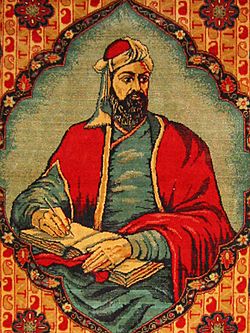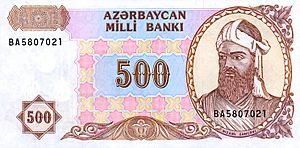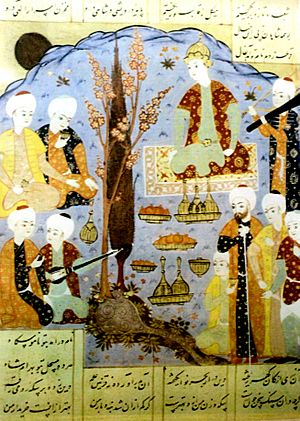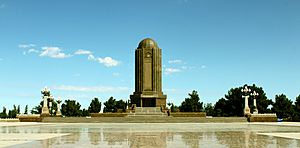Nizami Ganjavi facts for kids
Quick facts for kids
Nizami (Ganjavi)
|
|
|---|---|

Rug depiction of Nizami Ganjavi (1939). Ganja Museum, Azerbaijan.
|
|
| Born | 1141 (approximate) (Earlier date around c. 1130 has also been suggested) Ganja (Seljuk Persia, modern-day Azerbaijan) |
| Died | 1209 Ganja (Shirvanshah dynasty, modern-day Azerbaijan) |
| Period | 12th century |
| Genre | Romantic Persian epic poetry, Persian lyrical poetry, wisdom literature |
| Notable works | The Five Jewels (Panj Ganj) |
Nizami Ganjavi (Persian: نظامی گنجوی, romanized: Niẓāmī Ganjavī, lit. 'Niẓāmī of Ganja') lived from 1141 to 1209. His full name was Jamal ad-Din Abu Muhammad Ilyas ibn-Yusuf ibn-Zakki. He was a famous Persian poet from the 12th century.
Nizami is known as one of the greatest romantic epic poets in Persian literature. He made Persian epic poems feel more real and easy to understand. Many countries like Afghanistan, Azerbaijan, Iran, the Kurdistan region, and Tajikistan still admire his work today.
Contents
Life of Nizami Ganjavi
Nizami's personal name was Ilyas. He chose the pen-name Nezami. He was born in Ganja, which was part of the Great Seljuq Empire then. Today, Ganja is in the country of Azerbaijan.
It is believed that Nizami spent his whole life in the South Caucasus region. He became an orphan when he was young. His maternal uncle, Khwaja Umar, raised him. His uncle made sure he received an excellent education.
Nizami was not a poet who worked for a royal court. Because of this, there are not many official records about him. Most information about his life comes from old literary writings called Tazkerehs. These books often mix facts with legends and stories. So, we know only a few details about Nizami's personal life. Most of what we know comes from his own poems.
Nizami's Amazing Education
Nizami's poems show how much he knew. He was very familiar with Arabic and Persian literature. He also knew many popular local stories and traditions.
He studied many different subjects. These included mathematics, astronomy, and medicine. He also learned about botany, Islamic law, and Iranian myths. Nizami was also knowledgeable in history, ethics, philosophy, music, and visual arts.
Nizami's Family Life
Nizami was married three times during his life. His first wife was a woman sent to him as a gift from a ruler named Fakhr al-Din Bahramshah. She was his most beloved wife.
Nizami had one son named Mohammad with his first wife. Sadly, she passed away after he finished writing his famous poem "Khosrow and Shirin". At that time, Mohammad was seven years old.
Nizami's Famous Works
Nizami lived during a time of big changes in politics. It was also a time of great new ideas. His poems show these changes and ideas. He dedicated his poems to different rulers of the region. This was a common practice for great poets back then. However, Nizami chose to avoid working directly in the royal courts.
Nizami was a master of the Masnavi style of poetry. This style uses verses that rhyme in pairs.
Nizami's Lasting Legacy
Nizami wrote all his works in Persian. He is highly respected in Iran, Afghanistan, and Tajikistan, where Persian is the official language. His poetry is very popular in Iran. It is also well-loved in Azerbaijan, where he was born and where his tomb is located. People in other countries, like India and Pakistan, also know his work.
Nizami's poems have inspired many other artworks. For example, a Soviet ballet film called Leili and Medjnun was named after one of his poems. The ballet "Seven Beauties" by Azerbaijani composer Gara Garayev is based on another of Nizami's famous poems. This ballet has won international awards.
A small planet discovered in 1974 is named 3770 Nizami after him. The Nizami Museum of Azerbaijan Literature in Baku is also named in his honor.

Nizami's image was on the front of the Azerbaijani 500 manat banknote from 1993 to 2006. In 2008, a special 100 manat gold coin was made to remember him. This was for the 800th anniversary of his death.
The Nizami Museum of Azerbaijan Literature is in Baku, Azerbaijan. One of the Baku Metro stations is also named after Nizami Ganjavi. There is an Institute of Literature named after Nizami and a Cinema named after Nizami in Baku. Even a district of Baku is called Nizami raion.
Nizami's life was shown in the Azerbaijani movie "Nizami" (1982). The famous singer Muslim Magomayev played Nizami in the film.
The Nizami Mausoleum is a monument built to honor Nizami. It stands just outside the city of Ganja in Azerbaijan. It is a tall, round building surrounded by beautiful gardens. Next to it, there is a metal statue that shows scenes from Nizami's epic poems. The original mausoleum was built in 1947. It was rebuilt into its current form after Azerbaijan became independent in 1991.
Monuments to Nizami can be found in many cities. These include cities in Azerbaijan and Iran. There are also monuments in Moscow, St. Petersburg, and Udmurtiya (Russia). Other cities with monuments include Kiev (Ukraine), Beijing (China), Tashkent (Uzbekistan), Marneuli (Georgia), Chișinău (Moldova), and Rome (Italy).
Images for kids
-
Khosrow Parviz discovers Shirin bathing in a pool. From Nezami's poems in a Persian miniature, created around 1550.
-
Alexander shares his throne with Queen Nushabah. From the Sharaf-Nama.
-
Nizami Museum of Azerbaijani Literature in Baku, Azerbaijan.
-
Sassanid king, Bahram Gur in Nezami's "Bahram and the Indian Princess in the Black Pavilion".
-
A manuscript from Nizami's Khamsa (1494), showing Muhammad's journey.
-
1543 illustration of the Mi'raj from the Khamsa.
See also
 In Spanish: Nezamí Ganyaví para niños
In Spanish: Nezamí Ganyaví para niños
















